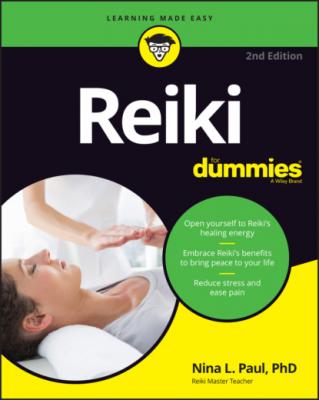ТОП просматриваемых книг сайта:
Reiki For Dummies. Nina L. Paul
Читать онлайн.Название Reiki For Dummies
Год выпуска 0
isbn 9781119894520
Автор произведения Nina L. Paul
Жанр Медицина
Издательство John Wiley & Sons Limited
We have Mikao Usui to thank for discovering the Reiki system of healing (Usui Reiki Ryoho) in 1922 in Japan. After Usui, various Japanese and Western Reiki practitioners interpreted and modified the system. As happens with the growth of any healthy tree, Reiki has developed many branches. This chapter gives an overview of how Usui Reiki Ryoho began in Japan and how it evolved into the current branches of Reiki.
What unites the branches of Reiki is that the main trunk is from Mikao Usui. After that, all Reiki branches diverge from the original to a greater or lesser extent.
Knowing the history and branches of Reiki helps you appreciate Reiki’s possibilities. This chapter can assist you in determining which branches are best for you.
Mikao Usui: The Founder of Reiki
The history of Reiki (see Table 3-1) begins with Mikao Usui, who was born in 1865 in Japan. During his lifetime, he practiced Tendai Buddhism and studied Japanese martial arts. He is also known to have read widely on topics of history, psychology, medicine, and religion from other cultures. He visited Western countries and China.
TABLE 3-1 A Timeline of Reiki’s Early Years
| Year | Location | Reiki Fact |
|---|---|---|
| 1865 | Japan | Mikao Usui is born. |
| 1880 | Japan | Chujiro Hayashi is born. |
| 1900 | Hawaii | Hawayo Takata is born. |
| 1922 | Japan | Mikao Usui spends 21 days at Mount Kurama. |
| 1926 | Japan | Mikao Usui dies of a stroke. |
| 1935 | Japan | Hawayo Takata is a client of Chujiro Hayashi. |
| 1937 | Hawaii | Hawayo Takata brings Reiki to Hawaii. |
| 1938 | Hawaii | Chujiro Hayashi gives Hawayo Takata a Master Certificate. |
| 1940 | Japan | Chujiro Hayashi dies by suicide (to avoid World War II). |
| 1976 | United States | Hawayo Takata trains her first Master student, Virginia Samdahl. |
| 1980 | United States | Hawayo Takata dies. |
| 1985 | Japan | Mieko Mitsui teaches the Western (Hawayo Takata/Barbara Weber Ray) version of Reiki in Japan. |
What makes Usui’s story extraordinary is that his drive to pursue his spiritual truth led him to discover Reiki, which has healed so many around the world.
Finding Reiki on the mountaintop
In 1922 Mikao Usui went for a spiritual pilgrimage to Mount Kurama, which is near Kyoto, Japan. Usui fasted and meditated for 21 days while he was on this retreat from the world. He sought a spiritual experience of enlightenment, total awareness, and deep peace.
Usui received the profound experience he was seeking along with the system of Reiki. He found that along with his spiritual awakening, he had the ability to heal himself and others.
Usui was a great healer and was reported to have helped many victims of the 1923 earthquake in Japan, which hit the cities of Tokyo and Yokohama.
Teaching Reiki to others
Mikao Usui began imparting his spiritual experiences to others. Hands-on healing and spiritual healing were popular in Japan in the early 1900s. Usui refined his teachings to a system that more closely resembles the Reiki that is taught today.
The aim of Usui’s teaching was to give students the tools for their own spiritual enlightenment and healing. Usui’s system of healing included the following:
Reiki principles (see Chapter 4)
Reiki hand positions (see Chapter 11)
Meditation (see Chapter 9)
Symbols and mantras (see Chapter 8)
Attunement (initiation) process (see Chapter 7)
Mikao Usui is known to have varied his teachings depending on the student, so the teachings that were passed on by each student would differ. (See the later section “Letting Reiki Branches Differ.”)
Some of Usui’s teachings (or derivations of his teachings) are found in a Japanese teaching manual called Usui Reiki Hikkei: The Usui Reiki Ryoho Gakkai Handbook, which has been translated from the Japanese. (See Frank Arjava Petter’s books in Appendix A and www.threshold.ca/reiki/Handouts/Threshold-Reiki--Reiki-Ryoho-Hikkei.pdf.) This manual provides insight into early Reiki teaching. It contains the following:
Reiki Principles (see Chapter 4), which were called “the secret method to invite happiness.”
“Usui’s Message about Reiki,” in which he introduces the concept of his teachings to the general public. (See the nearby sidebar “Usui Reiki Ryoho Gakkai.”)USUI REIKI RYOHO GAKKAIUsui Reiki Ryoho Gakkai began as a group of naval officers who had studied with Mikao Usui. Formed in 1926, it continues to be active. For decades the Gakkai has remained a relatively private and restricted society.The lineage of officers is as follows:Mikao UsuiJuzaburo UshidaKanichi TaketomiYoshiharu WatanabeHoichi WanamiKimiko KoyamaMasaki KondoTakahashi Ichita
Healing Guide, a series of hand positions that was probably developed by Chujiro Hayashi (see the later section “Exploring the Medical Approach: Chujiro Hayashi”); for

